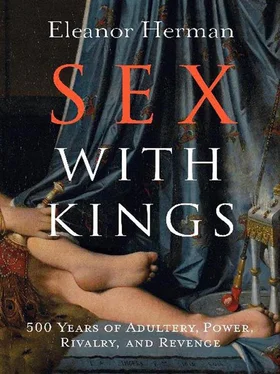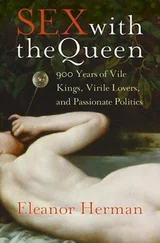Contemporary biographies started popping up, but even they must be scrutinized. Count Karl von Pöllnitz traveled the courts of Europe starting in 1710 and in 1740 became Frederick the Great’s master of ceremonies. Fascinated by the amorous adventures of Augustus the Strong of Saxony (1670–1733), who reputedly fathered more than three hundred illegitimate children, Count von Pöllnitz published a biography in 1734, the year after the king’s death. While the basic facts of the king’s love affairs were true, we can imagine that the count polished up the conversations he reported, for comic effect.
Along with literacy came a new appreciation of women’s valuable civilizing influence on society. The French court of the sixteenth century began accepting the idea that women were just as intelligent and capable as men, but infinitely more attractive. Almost overnight, royal mistresses became admired, imitated, and lauded.
In the sixteenth through the eighteenth centuries, the position of royal mistress was almost as official as that of prime minister. The mistress was expected to perform certain duties—sexual and otherwise—in return for titles, pensions, honors, and an influential place at court. She encouraged the arts—theater, literature, music, architecture, and philosophy. She wielded her charm as a weapon against foreign ambassadors. She calmed the king when he was angry, buoyed him up when he was despondent, encouraged him to greatness when he was weak. She attended religious services daily, gave alms to the poor, and turned in her jewels to the treasury in times of war.
François I of France (1494–1547) was the first king to give the title maîtresse-en-titre —official royal mistress—to his favorite. He enjoyed several mistresses in succession with great aplomb. By the second half of the sixteenth century, French mistresses wielded more power than any others in Europe would for nearly two hundred years. Diane de Poitiers, mistress of Henri II (1519–1559), became a member of the French council, an exclusive assembly convened for deliberating governmental matters. Diane made laws and imposed taxes, and she signed official decrees with the king in a joint signature, HenriDiane. Gabrielle d’Estrées, mistress of Henri IV (1553–1610), also joined the council, made laws, received ambassadors, and assisted greatly in ending the religious civil war.
Over in England, Henry VIII (1491–1547) made a muddle of things by insisting on marrying two women he lusted after and subsequently chopping off their heads. The following century Charles II lost no time mounting a mistress the very day he mounted the throne. On his coronation day in 1660 he bedded the auburn-haired Barbara Palmer, who nine months later gave him a daughter. As a reward he created her the countess of Castlemaine. Charles explained that “he was no atheist but he could not think God would make a man miserable for taking a little pleasure out of the way.” 3
Unburdened by fidelity—even to his mistress—Charles was one of the few monarchs who had several principal mistresses at his court at one time. He could never quite match the French for aplomb, and his harem closely resembled a squawking hen-house. The week of his death in 1685, the king was surrounded by all his hens, as described by the scandalized diarist John Evelyn, who lamented “the inexpressible luxury and profaneness, gaming and all dissoluteness” he witnessed. King Charles was “sitting and toying with his concubines Portsmouth, Cleveland, and Mazarin, etc., a French boy singing love songs in that glorious gallery, whilst about twenty of the great courtiers and other dissolute persons were at basset [a card game] round a large table, a bank of at least 2000 in gold before them.” 4
Charles’s first cousin Louis XIV of France ornamented his court with a string of fragrant mistresses. Athénaïs de Montespan—who boasted a tenure of thirteen years—was in many ways a clone of her English counterpart Barbara, Lady Castlemaine, who held sway for a dozen years. Both were beautiful, grasping, hard, and glittering, though Athénaïs was to her contemporaries perhaps the more palatable, her rough edges smoothed over by a healthy smearing of French panache. Both added to the glory of their respective nations, all the while looting the treasury, and both were sorely missed when they were replaced by less colorful substitutes.
Even as French fashion, architecture, music, and art were replicated in paler versions throughout Europe, so was the French concept of the maîtresse-en-titre . By the late seventeenth century, the role of royal mistress at a great court was considered so indispensable that even the stuffy German kingdoms followed suit. Frederick III, elector of Brandenburg (1657–1713), an uxorious prince who despised infidelity, appointed a beautiful court lady as his official mistress and loaded her down with jewels, even though he never touched her—his wife would have killed him.
Augustus the Strong of Saxony was chosen king of Poland in 1697 and suddenly found himself ruling two nations. He had a mistress of nine years’ standing in Saxony, and his minister advised him to choose a Polish woman for the same honor in Warsaw. According to Count von Pöllnitz, the king was advised as follows: “For, as your Majesty has two Courts, one in Saxony, and the other at Warsaw, you ought to be a complete monarch, and in justice, keep a mistress at each Court. This will conduce undoubtedly to the satisfaction of both nations. At present the Polanders except against your keeping a Saxon mistress. If you forsake her, to be enamored with a Polish lady, the Saxons will find equal reason to complain. Whereas by being amorous six months in Poland, and the other six months in Saxony, both nations will be satisfied.” 5
While the seventeenth-century kings of France, England, and Germany were kicking up their heels with well-rewarded mistresses, the royal court of Spain remained an oasis of suffocating medieval Catholicism. The land that spawned the Inquisition was more pious than the Vatican, where rollicking cardinals indulged in lively orgies. Genetically unsound, the desiccated Spanish kings ruled over a somber court where the mass burning of heretics constituted the favorite spectator sport.
The Spanish royal mistress had no recognized position, certainly no hope of acquiring power at court, and very little in the way of financial reward. Her life after dismissal was even more dismal—she was banished to a convent. The king being only one step away from God, no ordinary mortal could hope to touch a woman who had been sanctified by the monarch’s embraces.
It was reported that Philip IV of Spain (1605–1665) chased a young woman through his palace and hurled himself at the door she had barred against him, commanding her to let him in. The sobbing girl cried, “No, no, Sire! I don’t want to be a nun!” 6
King John V of Portugal (1689–1750) didn’t bother sending his dismissed mistresses to a convent; he found his mistresses among nuns, turning one Lisbon convent into his personal harem and child care center. The mother superior provided him with a son who grew up to be an archbishop.
But Iberian customs were not popular with the rest of Europe. Trying to imitate Charles II, when George, elector of Hanover (1660–1727), inherited the throne of Great Britain in 1714, he imported not one, but two royal mistresses into his new land. George’s German mistresses failed to impress his British subjects, who were shocked—not at his moral laxity, but at his taste in women. One was tall and thin to the point of emaciation, the other short and fat enough to burst, the pair of them hopelessly ugly . For his part, the king was pleased when his English subjects ridiculed his mistresses, even when someone sent an old nag with a broken saddle through the streets of London bearing a sign that read, “Let nobody stop me—I am the King’s Hanover equipage going to fetch His Majesty and his whore to England.” 7Such jokes reflected well on his masculinity, George concluded.
Читать дальше












